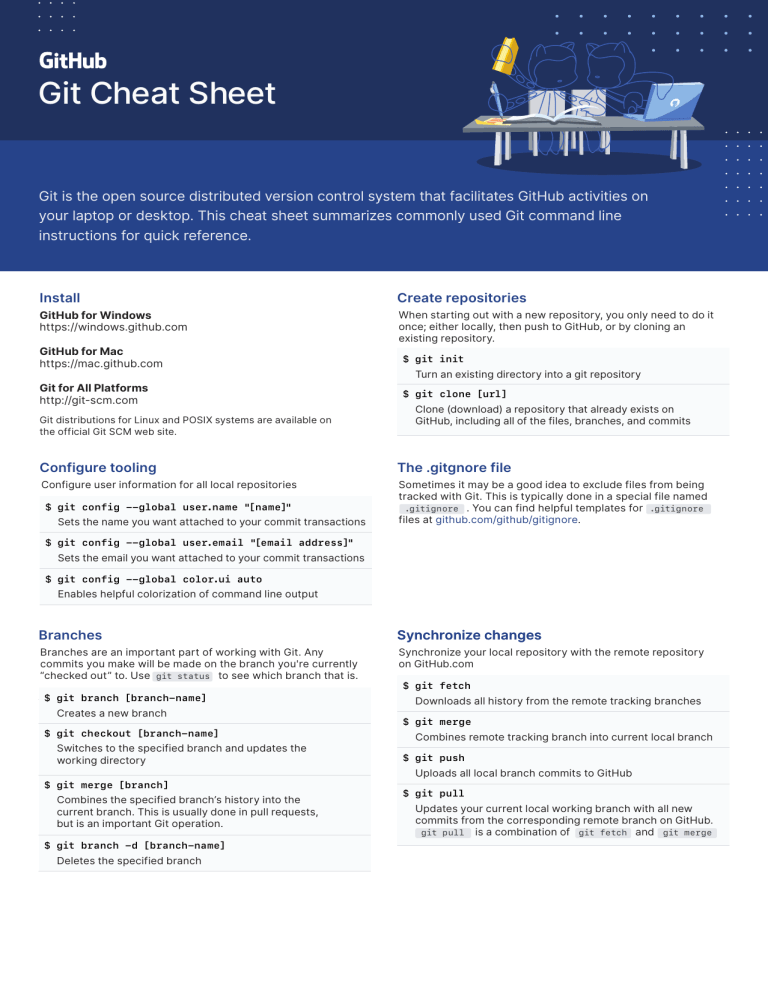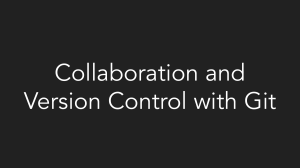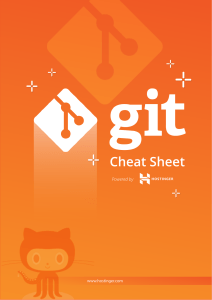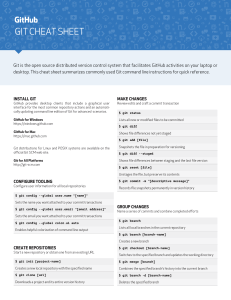
Git Cheat Sheet Git is the open source distributed version control system that facilitates GitHub activities on your laptop or desktop. This cheat sheet summarizes commonly used Git command line instructions for quick reference. Install Create repositories GitHub for Windows https://windows.github.com When starting out with a new repository, you only need to do it once; either locally, then push to GitHub, or by cloning an existing repository. GitHub for Mac https://mac.github.com Git for All Platforms http://git-scm.com Git distributions for Linux and POSIX systems are available on the official Git SCM web site. $ git init Turn an existing directory into a git repository $ git clone [url] Clone (download) a repository that already exists on GitHub, including all of the files, branches, and commits Configure tooling The .gitgnore file Configure user information for all local repositories Sometimes it may be a good idea to exclude files from being tracked with Git. This is typically done in a special file named .gitignore . You can find helpful templates for .gitignore files at github.com/github/gitignore. $ git config --global user.name "[name]" Sets the name you want attached to your commit transactions $ git config --global user.email "[email address]" Sets the email you want attached to your commit transactions $ git config --global color.ui auto Enables helpful colorization of command line output Branches Synchronize changes Branches are an important part of working with Git. Any commits you make will be made on the branch you're currently “checked out” to. Use git status to see which branch that is. Synchronize your local repository with the remote repository on GitHub.com $ git branch [branch-name] Creates a new branch $ git checkout [branch-name] Switches to the specified branch and updates the working directory $ git merge [branch] Combines the specified branch’s history into the current branch. This is usually done in pull requests, but is an important Git operation. $ git branch -d [branch-name] Deletes the specified branch $ git fetch Downloads all history from the remote tracking branches $ git merge Combines remote tracking branch into current local branch $ git push Uploads all local branch commits to GitHub $ git pull Updates your current local working branch with all new commits from the corresponding remote branch on GitHub. git pull is a combination of git fetch and git merge Git Cheat Sheet Make changes Redo commits Browse and inspect the evolution of project files Erase mistakes and craft replacement history $ git log $ git reset [commit] Lists version history for the current branch Undoes all commits after [commit], preserving changes locally $ git log --follow [file] $ git reset --hard [commit] Lists version history for a file, including renames Discards all history and changes back to the specified commit $ git diff [first-branch]...[second-branch] CAUTION! Changing history can have nasty side effects. If you need to change commits that exist on GitHub (the remote), proceed with caution. If you need help, reach out at github.community or contact support. Shows content differences between two branches $ git show [commit] Outputs metadata and content changes of the specified commit $ git add [file] Snapshots the file in preparation for versioning $ git commit -m "[descriptive message]" Records file snapshots permanently in version history GitHub Flow ‘master’ branch Create ‘feature’ branch from ‘master’ Commit changes Submit Pull Request Merge ‘feature’ branch into ‘master’ Discuss proposed changes and make more commits Glossary git: an open source, distributed version-control system GitHub: a platform for hosting and collaborating on Git repositories commit: a Git object, a snapshot of your entire repository compressed into a SHA branch: a lightweight movable pointer to a commit clone: a local version of a repository, including all commits and branches remote: a common repository on GitHub that all team member use to exchange their changes fork: a copy of a repository on GitHub owned by a different user pull request: a place to compare and discuss the differences introduced on a branch with reviews, comments, integrated tests, and more HEAD: representing your current working directory, the HEAD pointer can be moved to different branches, tags, or commits when using git checkout Training Want to learn more about using GitHub and Git? Email the Training Team or visit our web site for learning event schedules and private class availability. services@github.com services.github.com








